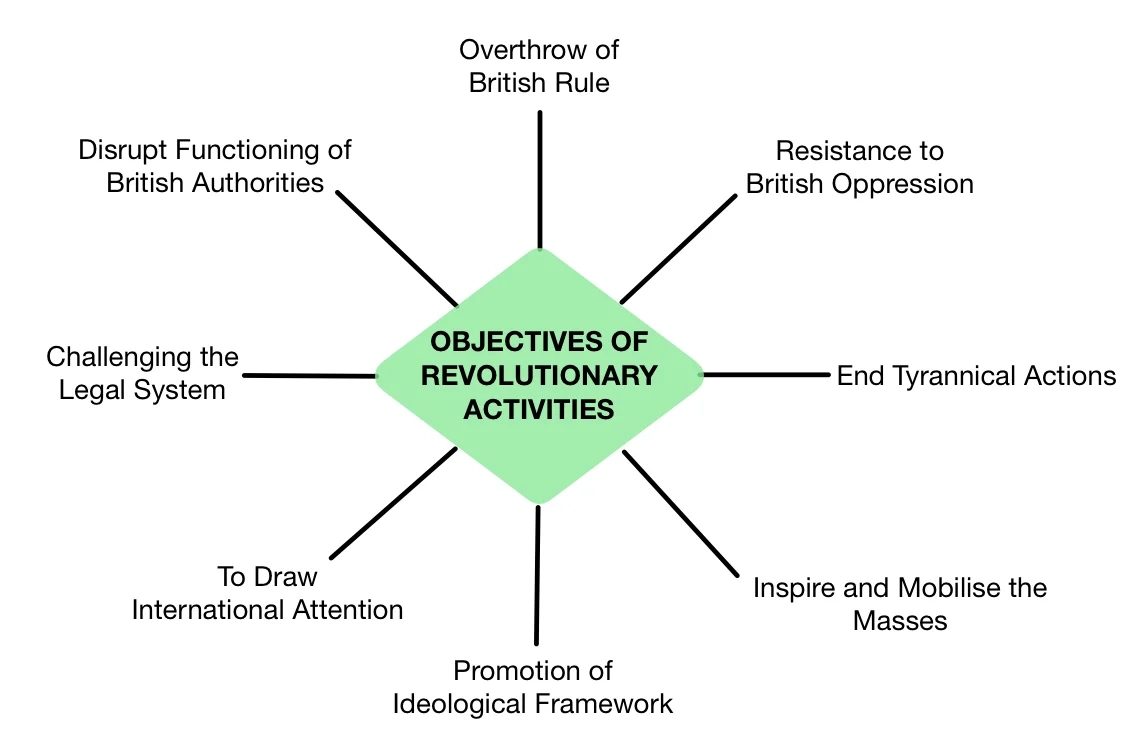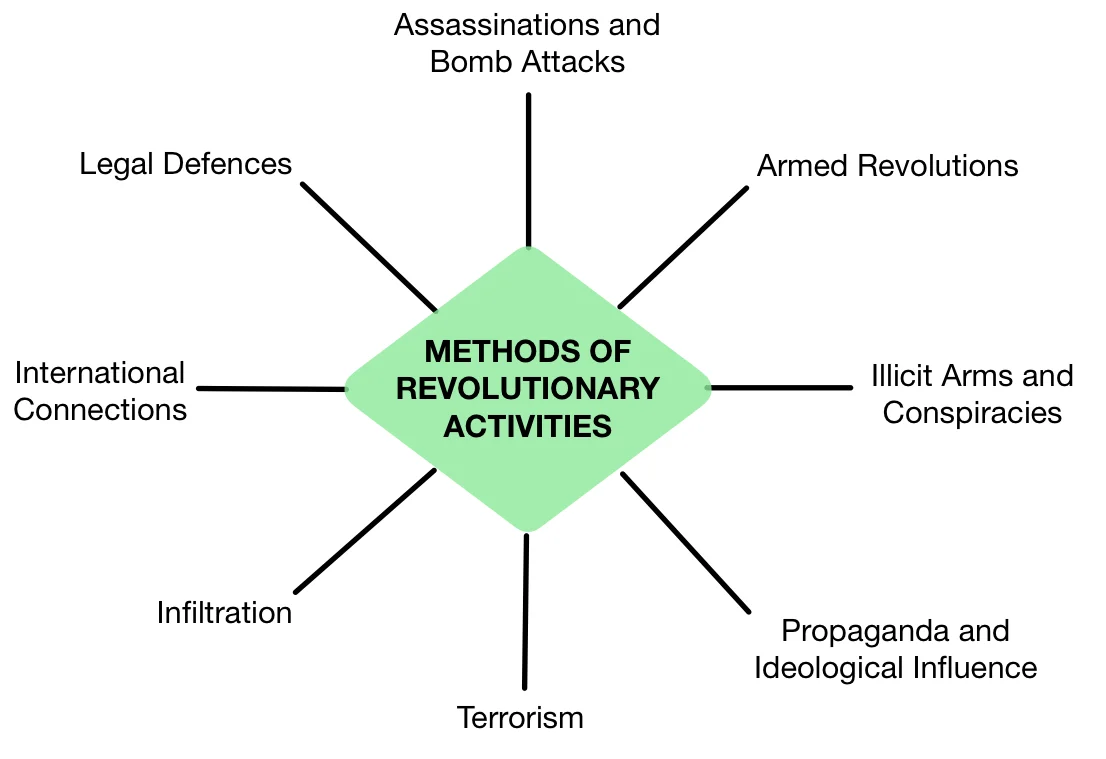Revolutionary activities refer to actions and strategies employed by individuals or groups to bring about significant political, social, or ideological change through unconventional and often forceful means. By the end of 1907, a new political trend emerged in Bengal. Young and impatient individuals from the region began to embrace the path of individual heroism and revolutionary nationalism. These individuals turned to such actions primarily because they felt there was no other means available to express their patriotism and their desire for political change.
Emergence of Revolutionary Activities
The emergence of revolutionary nationalism was a consequence of militant nationalism. The initial phase gained momentum after the end of the Swadeshi movement and lasted until 1917. The second phase emerged after the fallout of the Non-Cooperation Movement.
Factors Leading to Revolutionary Activities
Demise of Moderate Leadership
- British policy makers believed that the Congress, under Moderate leadership, was vulnerable and lacked popular support. Lord Curzon, in particular, with the backing of George Hamilton, actively pursued a policy to undermine the Congress, viewing it as weak and on the brink of collapse.
Curzon’s Reactionary Policies
- In 1900, Curzon stated, “The Congress is tottering to its fall, and one of my greatest ambitions while in India is to assist it to a peaceful demise.” He remained committed to this objective.
- In 1903, he wrote to the Governor of Madras, “My policy, ever since I came to India, has been to reduce the Congress to impotence.” In 1904, he even insulted the Congress by refusing to meet with its delegation, which was led by the Congress President.
Weak leadership after the Decline of the Swadeshi Movement:
- Disillusionment with Leadership: Following the decline of the open movement, young nationalists who had been involved in it sought ways to express their patriotic fervour.
- However, they were disheartened by the leadership’s inability, including the Extremists, to devise new forms of struggle to implement the emerging militant trends.
- Challenges of Extremist Leadership: Even though the Extremist leaders urged the youth to make sacrifices, they couldn’t establish an effective organization or develop new methods of political action to harness this revolutionary spirit.
- Turn to Physical Force: With peaceful political protests hampered by government repression, the youth believed that physical force was necessary to achieve the nationalist goal of independence by expelling the British.
The objective of Revolutionary Activities
The Objective of Revolutionary Nationalism was to create terror in the hearts of the imperialists, mobilize people, and remove the fear of authority from their minds. The revolutionaries intended to inspire the people by appealing to their patriotism, especially the idealistic youth who would finally drive the British out.

Methods Used By Revolutionary
- Disappointment with Extremist Leadership: The revolutionaries considered various options, including a nationwide violent revolution and attempts to undermine the loyalty of the Army.
- The Extremist leadership disappointed the young activists. While the leaders praised the youth’s self-sacrifice and bravery, they failed to channel their revolutionary energy positively.

- Lack of Political Education: The leaders didn’t educate them about the political distinctions between a revolution driven by mass action and one rooted in individual heroic deeds.
- Additionally, the leadership didn’t challenge the idea that being a revolutionary equated to endorsing violent actions.
- Aurobindo Ghose, in particular, seemed to encourage this notion. However, they decided to follow the examples of Russian nihilists and Irish nationalists.
- Focus on Heroic Acts: Their approach involved individual acts of heroism, such as organizing the assassination of unpopular officials, traitors, and informers within their ranks, and conducting swadeshi dacoities to raise funds for revolutionary activities.
- Military Conspiracies: During the First World War, military conspiracies with the hope of assistance from Britain’s enemies.
- Their goal was to instill fear in the rulers, awaken the masses, and remove the fear of authority from their minds.
- Appealing to Patriotism and Idealistic Youth: The revolutionaries aimed to inspire people by appealing to their patriotism, particularly the idealistic youth, who they believed would ultimately expel the British.
| Must Read | |
| Current Affairs | Editorial Analysis |
| Upsc Notes | Upsc Blogs |
| NCERT Notes | Free Main Answer Writing |
Conclusion
The revolutionary activities from 1907 to 1917 epitomized the fervent quest for political change amid colonial repression. Frustrated by ineffective leadership and persistent British hostility, young nationalists turned to drastic measures, including individual heroism and militant actions. They aimed to disrupt British control, inspire the masses, and galvanize patriotism, hoping that their radical efforts would ultimately lead to India’s independence. This period highlights a pivotal transition from moderate protests to revolutionary zeal.
Sign up for the PWOnlyIAS Online Course by Physics Wallah and start your journey to IAS success today!
| Related Articles | |
| Non Cooperation Movement 1920 | Lord Curzon (1899-1905) |
| Important Congress Sessions: Presidents, Milestones, and Impact | Swadeshi Movement: Spread, Extremist & Moderate Phase |

 GS Foundation
GS Foundation Optional Course
Optional Course Combo Courses
Combo Courses Degree Program
Degree Program









